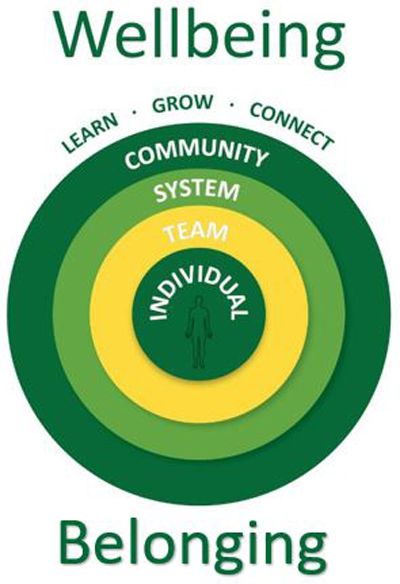Wellbeing & Resilience
What is wellbeing and resilience?
Wellbeing, in general, is our ability to feel good and to function effectively. A positive state of wellbeing is characterized by overall contentment and balance in one’s life.
Resilience is the capacity to withstand and bounce forward when faced with adversity. Resilient individuals, teams, systems and communities are flexible and adaptable. They have the ability to learn, grow, and to lead and navigate through challenging circumstances and weather change.
Wellbeing and resilience online toolkit
This area of the website is designed to provide an array of resources, tools and practices to enhance physical, psychological, emotional, spiritual wellbeing and resilience and foster our common goals to Learn, Grow and Connect.
According to the Resilience Institute, as human beings—like many living creatures—we have good days and bad days, highs and lows, ups and downs. On the whole, these are all a part of a normal, natural, and adaptive response. We have to be intentional in leading self to find the cadence or rhythm that works for us, individually and as teams, that allows for the effective balance of performance and care—balance ‘doing good’ with deliberate intensity to achieve results and ‘being well’ through engagement, rest and renewal. We need the resources to navigate the highs and lows we all experience in our daily lives and live well, despite the struggles.
Additional information can be found in the 2023 Global Resilience Report as it explores the state of global resilience through the human capacity to bounce, grow, connect, and flow.
Wellbeing and resilience in the workplace
Wellbeing and resilience in the workplace is a shared responsibility. We all have a part to play in pursuit of our mission: We work together to improve health and well-being. Every day. For everyone. At the SHA we appreciate that wellbeing and resilience are multidimensional and operate at 4 levels – individual, team, system and community.
- Me (individual health-care workers (HCWs))
- We (leaders and teams)
- Us (whole organization and community)
This means we apply a systems approach to safety and effectively care for wellbeing, foster resilience and prevent burnout. We do this through supporting and practicing self-care, while navigating both the good times and successes and the challenges and struggles that occur. As well as assessing and addressing system factors and psychosocial hazards and risks— that get in the way of maintaining healthy relationships, creating effective teams, and providing high-quality and safe care and service to those we serve.
Wellbeing dimensions
Taking care of our own wellbeing and supporting the wellbeing of others requires intentional action. Acknowledging and effectively managing stress, both acute and cumulative, is key to fostering individual and collective wellbeing and resilience over time.
At the individual level, wellbeing is a wholistic state of being, inclusive of the following dimensions:
- Body (Physical) Maintenance of strength, endurance and flexibility.
- Mind (Psychological) Capacity for optimism, focus and effective decisions.
- Emotion (Emotional) Capacity for emotional awareness & regulation of self/others (i.e. emotional intelligence), empathy and compassion.
- Spirit (Spiritual) Capacity for meaning, purpose and joy in life.
For more information or if you have questions, please email SHAWellbeingandResilience@saskhealthauthority.ca.
Emergency Care
If you are in distress, call 9-1-1.
For additional information on suicide prevention, contact the Canadian Association for Suicide Prevention or Crisis Services Canada.



